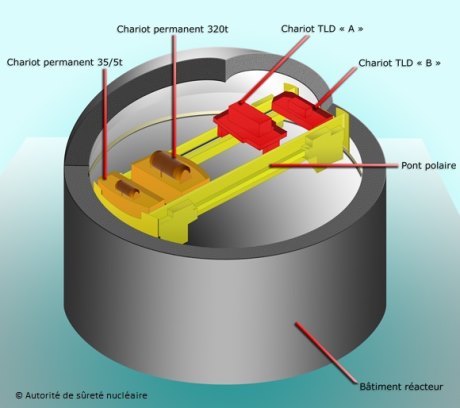The French nuclear regulator has directed EDF not to use the polar crane and associated heavy lifting equipment at the Flamanville EPR construction site until its concerns over compliance issues have been addressed.
 |
| Flamanville's polar crane and lifting equipment: The TLDs are shown in red (Image: ASN) |
The polar crane is a permanent part of a pressurized water reactor building, running on circular rails inside the dome. Inspections by the ASN (Autorité de Sûreté Nucléaire) in recent months aroused its concerns about the lack of an emergency stop that would be able to simultaneously halt both the polar crane's trolleys and two temporary trolleys (referred to as temporary lifting devices, TLDs), and also the lack of a global load limiter in the case of simultaneous use of at least two of the crane's trolleys.
The ASN says that it has not yet received all the answers and guarantees it requires from EDF, and has now instructed the company not to use the equipment until a final compliance report has been completed and an action plan to remedy any non-compliance has been implemented.
Polar cranes are used to lift reactor vessel heads, internals and other loads during refuelling outages. They are also used to lift heavy items such as the reactor vessel itself and the steam generators, both during plant construction and also in later major work such as steam generator replacement. TLDs are sometimes used in such operations. As similar equipment is in use at operating nuclear power plants, the regulator has also instructed EDF to identify any non-compliance with polar cranes and TLDs used for steam generator replacement work at operating plants, and to implement the necessary remedies.
Flamanville 3's polar crane is designed, manufactured and supplied by EDF Apco. As well as the polar crane's two permanent trolleys, the ASN's direction applies to two TLDs which are installed on the crane's bridge-beams to handle heavy equipment during the reactor's construction. The TLDs, made by Dutch company Mammoet, are to be dismantled before the reactor is commissioned.
Flamanville 3 is one of four EPRs under construction, with the first-of-a-kind plant being built at Olkiluoto in Finland. Although work began on Olkiluoto in 2005 and Flamanville in 2007, the first projects have suffered various delays and neither unit is expected to start up until 2016. Two units being built at Taishan in China seem more likely to be the first EPRs to supply electricity, with start-ups currently scheduled for 2014 and 2015.
Researched and written
by World Nuclear News




_18570.jpg)
_16159.jpg)
_18938.jpg)
_33584.jpg)





